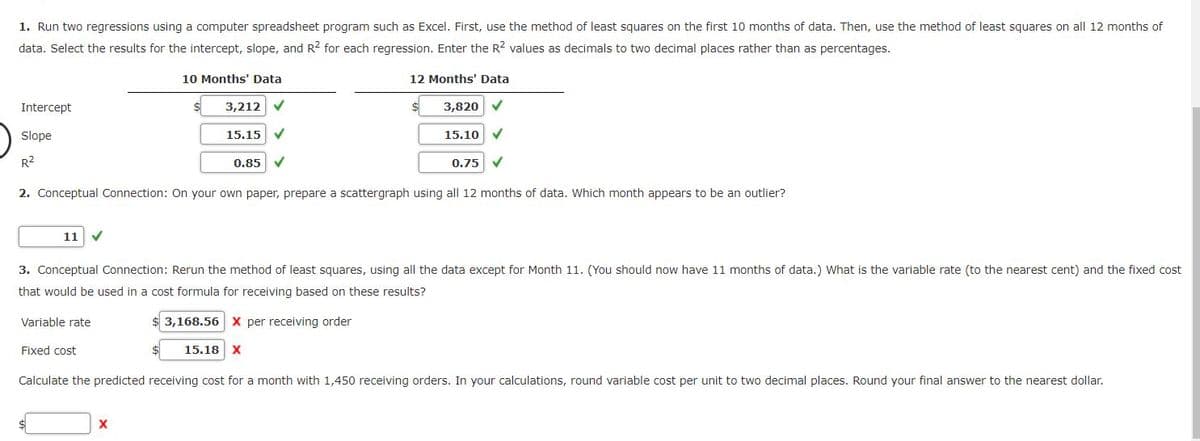Rerun the method of least squares, using all the data except for Month 11. (You should now have 11 months of data.) What is the variable rate (to the nearest cent) and the fixed cost that would be used in a cost formula for receiving based on these results? Variable Rate: _______________ Fixed Cost:_________________ Calculate the predicted receiving cost for a month with 1,450 receiving orders. In your calculations, round variable cost per unit to two decimal places. Round your final answer to the nearest dollar.
Process Costing
Process costing is a sort of operation costing which is employed to determine the value of a product at each process or stage of producing process, applicable where goods produced from a series of continuous operations or procedure.
Job Costing
Job costing is adhesive costs of each and every job involved in the production processes. It is an accounting measure. It is a method which determines the cost of specific jobs, which are performed according to the consumer’s specifications. Job costing is possible only in businesses where the production is done as per the customer’s requirement. For example, some customers order to manufacture furniture as per their needs.
ABC Costing
Cost Accounting is a form of managerial accounting that helps the company in assessing the total variable cost so as to compute the cost of production. Cost accounting is generally used by the management so as to ensure better decision-making. In comparison to financial accounting, cost accounting has to follow a set standard ad can be used flexibly by the management as per their needs. The types of Cost Accounting include – Lean Accounting, Standard Costing, Marginal Costing and Activity Based Costing.
(Appendix 3A) Method of Least Squares
Farnsworth Company has gathered data on its overhead activities and associated costs for the past 10 months. Tracy Heppler, a member of the controller's department, has convinced management that overhead costs can be better estimated and controlled if the fixed and variable components of each overhead activity are known. One such activity is receiving raw materials (unloading incoming goods, counting goods, and inspecting goods), which she believes is driven by the number of receiving orders. Ten months of data have been gathered for the receiving activity and are as follows:
| Month | Receiving Orders | Receiving Cost | |||
| 1 | 1,000 | $18,000 | |||
| 2 | 700 | 15,000 | |||
| 3 | 1,500 | 28,000 | |||
| 4 | 1,200 | 17,000 | |||
| 5 | 1,300 | 25,000 | |||
| 6 | 1,100 | 21,000 | |||
| 7 | 1,600 | 29,000 | |||
| 8 | 1,400 | 24,000 | |||
| 9 | 1,700 | 27,000 | |||
| 10 | 900 | 16,000 |
Suppose that Tracy has gathered two more months of data:
| Month | Receiving Orders | Receiving Cost | |||
| 11 | 1,200 | $28,000 | |||
| 12 | 950 | 17,500 |
Note:For the following requirements, round the intercept terms to the nearest dollar, round the variable rates to the nearest cent, and R2 to two decimal places.
Hi there,
I am just missing question#3
3. Conceptual Connection: Rerun the method of least squares, using all the data except for Month 11. (You should now have 11 months of data.) What is the variable rate (to the nearest cent) and the fixed cost that would be used in a cost formula for receiving based on these results?
Variable Rate: _______________
Fixed Cost:_________________
Calculate the predicted receiving cost for a month with 1,450 receiving orders. In your calculations, round variable cost per unit to two decimal places. Round your final answer to the nearest dollar.
______________

Trending now
This is a popular solution!
Step by step
Solved in 4 steps with 5 images




